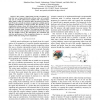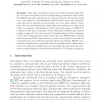58 search results - page 11 / 12 » Facial action unit recognition with sparse representation |
ISCAS
2007
IEEE
14 years 3 days ago
2007
IEEE
Abstract— We present a spike-based saccadic recognition system that uses a temporal-derivative silicon retina on a pan-tilt unit and an aVLSI multi-neuron classifier with a time...
CVPR
2012
IEEE
11 years 8 months ago
2012
IEEE
A greedy-based approach to learn a compact and discriminative dictionary for sparse representation is presented. We propose an objective function consisting of two components: ent...
NN
2002
Springer
13 years 5 months ago
2002
Springer
Recognition-by-components is one of the possible strategies proposed for object recognition by the brain, but little is known about the low-level mechanism by which the parts of o...
MMM
2006
Springer
13 years 11 months ago
2006
Springer
Accessing specific or salient parts of multimedia recordings remains a challenge as there is no obvious way of structuring and representing a mix of space-based and timebased med...
ECCV
2000
Springer
14 years 7 months ago
2000
Springer
This paper describes a novel view-based learning algorithm for 3D object recognition from 2D images using a network of linear units. The SNoW learning architecture is a sparse netw...


